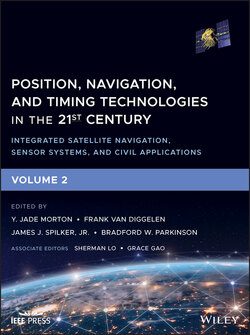Читать книгу Position, Navigation, and Timing Technologies in the 21st Century - Группа авторов - Страница 67
38.1 Introduction
ОглавлениеAmong the different types of signals of opportunity, cellular signals are particularly attractive for positioning, navigation, and timing (PNT) due to their inherently attractive characteristics:
AbundanceCellular base transceiver stations (BTSs) are plentiful due to the ubiquity of cellular and smartphones and tablets. The number of BTSs is bound to increase dramatically with the introduction of small cells to support fifth‐generation (5G) wireless systems.
Geometric diversityThe cell configuration by construction yields favorable BTS geometry, unlike certain terrestrial transmitters, which tend to be colocated (e.g. digital television). Such geometric diversity yields low geometric dilution of precision (GDOP) factors, which results in a precise PNT solution.
High carrier frequencyThe current cellular carrier frequency ranges between 800 MHz and 1900 MHz, which yields precise carrier phase navigation observables. Future 5G networks will tap into frequencies between 30 and 300 GHz.
Large bandwidthCellular signals have a large bandwidth, which yields accurate time‐of‐arrival (TOA) estimation (e.g. the bandwidth of certain cellular long‐term evolution (LTE) reference signals is up to 20 MHz).
High transmitted powerCellular signals are often available and usable in environments where global navigation satellite system (GNSS) signals are challenged (e.g. indoors and in deep urban canyons). The received carrier‐to‐noise ratio, C/N0, from nearby cellular BTSs is more than 20 dB‐Hz than that received from GPS space vehicles (SVs).
Free to useThere is no deployment cost associated with using cellular signals for PNT – the signals are practically free to use. Specifically, the user equipment (UE) could “eavesdrop” on the transmitted cellular signals without communicating with the BTS, extract necessary PNT information from received signals, and calculate the navigation solution locally. While other navigation approaches requiring two‐way communication between the UE and BTS (i.e. network‐based) exist, this chapter focuses on explaining how UE‐based navigation could be achieved.
Regardless of whether GNSS signals are available or not, cellular signals of opportunity could be used to produce or improve the navigation solution. In the absence of GNSS signals, cellular signals could be used to produce a navigation solution in a stand‐alone fashion or to aid the inertial navigation system (INS) [1–6]. When GNSS signals are available, cellular signals could be fused with GNSS signals, yielding a navigation solution that is superior to a stand‐alone GNSS solution, particularly in the vertical direction [7, 8].
Cellular signals are not intended for PNT. Therefore, to use these signals for such purpose, several challenges must be addressed. This has been the subject of extensive research over the past few years. These challenges and potential remedies are summarized next.
Cellular signals are modulated and subsequently transmitted for non‐PNT purposes. These signals are much more complicated than GNSS signals, and extracting relevant PNT information from them is not straightforward. Recent research has focused on deriving appropriate low‐level models to optimally extract states and parameters of interest for PNT from received cellular signals. The effect of different propagation channels on such signals is an ongoing area of research [9–15].
GNSS receivers are commercially available, and there is a rich body of literature on GNSS receiver design. This is not the case for cellular navigation receivers. The recent literature has published specialized receiver designs for producing navigation observables from received cellular signals (e.g. code phase, carrier phase, and Doppler frequency) [16–19].
GNSS SVs are equipped with atomic oscillators and are tightly synchronized. However, cellular towers are equipped with less stable oscillators, typically oven‐controlled crystal oscillators (OCXOs), and are less tightly synchronized. This is because communication synchronization requirements are less stringent than PNT synchronization requirements. Timing errors arising due to this somewhat loose synchronization could introduce tens of meters of localization error. Researchers have been modeling such errors and synthesizing PNT estimators that compensate for them [20–25].
GNSS SVs transmit all necessary states and parameters to the receiver in the navigation message (e.g. SV position, clock bias, ionospheric model parameters, etc.). In contrast, cellular BTSs do not transmit such information. Therefore, navigation frameworks must be developed to estimate the states and parameters of cellular BTSs (position, clock bias, clock drift, frequency stability, etc.), which are not necessarily known a priori. Several navigation frameworks have been proposed. One such framework is to have a dedicated station that acts as a mapper, which knows its states (from GNSS signals, for instance), is estimating the unknown states of cellular BTSs, and is sharing such estimates with navigating receivers. Another framework is to simultaneously estimate the states of the receiver and cellular BTSs in a radio simultaneous localization and mapping (radio SLAM) manner [26–29].
This chapter discusses how cellular signals could be used for PNT by presenting relevant signal models, receiver architectures, PNT sources of error and corresponding models, navigation frameworks, and experimental results. The remainder of this chapter is organized as follows. Section 38.2 gives a brief overview of the evolution of cellular systems. Section 38.3 discusses modeling the clock error dynamics to facilitate estimating the unknown BTSs’ clock error states. Section 38.4 describes two frameworks for navigation in cellular environments. Sections 38.5 and 38.6 discuss how to navigate with cellular code‐division multiple access (CDMA) and LTE signals, respectively. Section 38.7 discusses a timing error that arises in cellular networks: clock bias discrepancy between different sectors of a BTS cell. Section 38.8 highlights the achieved navigation solution improvement upon fusing cellular signals with GNSS signals. Section 38.9 describes how cellular signals could be used to aid an INS.
Throughout this chapter, italic small bold letters (e.g. ) represent vectors in the time domain, italic capital bold letters (e.g. ) represent vectors in the frequency domain, and capital bold letters represent matrices (e.g. X).
